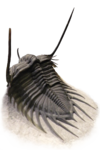
Calymene Brongniart, 1822, is a genus of trilobites in the order Phacopida, suborder Calymenina, that are found throughout North America, North Africa, and Europe in primarily Silurian outcrops. Calymene is closely related to Flexicalymene, and both genera are frequently found enrolled. Calymene trilobites are small, typically 2 cm in length. The cephalon is the widest part of the animal and the thorax usually has 13 segments.

Selenopeltis is an extinct genus of odontopleurid trilobites in the family Odontopleuridae.

Balizoma is a genus of trilobites from the family Encrinuridae established by David J. Holloway in 1980. It has only been found in rocks of Silurian age. Its type species, B. variolaris, is currently the only named species of the genus, and is found in England. The neotype of B. variolaris was collected from the Much Wenlock Limestone Formation at Dudley, West Midlands. That specimen was first illustrated in Sir Roderick Impey Murchison's classic book, The Silurian System. B. variolaris was the original "strawberry-headed" trilobite of Dudley, so-named because of its nodular glabellar tubercles, and well known to early trilobite collectors. Additional species were originally assigned to Balizoma, but were subsequently placed in other encrinurine genera.

Acastoides is an extinct genus of trilobite that lived during the Silurian and Devonian. It has been found in Bolivia, France, Morocco, Poland, Turkey and the United Kingdom.

Acernaspis is an extinct genus of trilobite that is known from the Silurian. It contains two species, A. elliptifrons, and A. salmoensis. It is sometimes found preserved in burrows of various forms, sometimes in association with multiple moults, suggesting that it used tunnels as refuges whilst in its vulnerable moulting stage.
Avalanchurus is an extinct genus of trilobites from the Silurian period. It was originally described in 1993 as a subgenus of Struszia, and then promoted in 1997 to genus status.
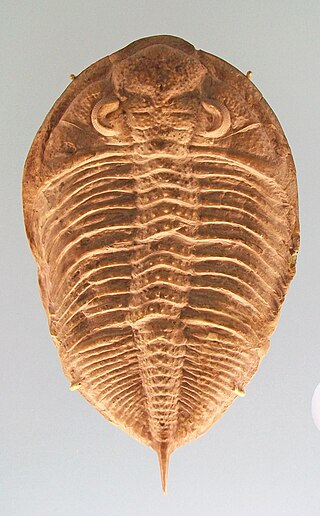
Glyptambon is an extinct genus of Silurian trilobite in the order Phacopida. It is a member of the family Dalmanitidae and the subfamily Dalmanitinae, although it has been classified in the related Ordovician subfamily Mucronaspidinae. The type species G. verrucosus was previously placed in Dalmania and later in Dalmanites. Because this species was considered distinct from other Dalmania and Dalmanites species, the new genus Glyptambon was erected for it in 1981.G. amsdeni and G. gassi were named in 1991 from Tennessee and Illinois, respectively.
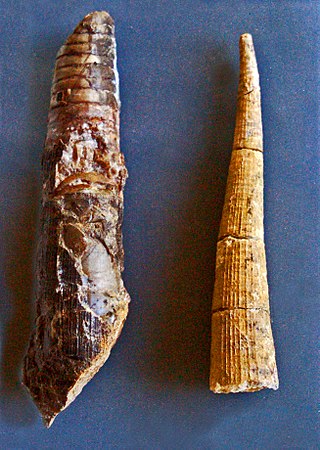
Kionoceras is an extinct nautiloid cephalopod genus included in the orthocerid family Kionoceratidae with scattered worldwide distribution from the Middle Ordovician to the Lower Permian. Kionoceratids are orthocerids with prominent longitudinal ornamentation on their shells, sometimes augmented by secondary transverse ornamentation. Orthocerids are, of course, prehistoric nautiloides with generally straight and elongate shells, mostly with central or subcentral siphuncles.
Zacanthoides is an extinct Cambrian genus of corynexochid trilobite. It was a nektobenthic predatory carnivore. Its remains have been found in Canada, Greenland, Mexico, and the United States. Its major characteristics are a slender exoskeleton with 9 thoracic segments, pleurae with long spines, additional spines on the axial rings, and a pygidium that is considerably smaller than its cephalon.
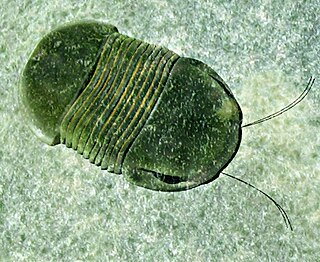
Bumastus is an extinct genus of corynexochid trilobites which existed from the Early Ordovician period to the Late Silurian period. They were relatively large trilobites, reaching a length of 6 in (15 cm). They were distinctive for their highly globular, smooth-surfaced exoskeleton. They possessed well-developed, large compound eyes and were believed to have dwelled in shallow-water sediments in life.
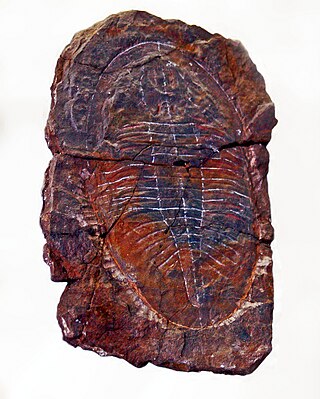
Birmanites is a genus of trilobites in the order Asaphida, family Asaphidae.

Planiscutellum is a genus of trilobites in the order Corynexochida family Styginidae. These trilobites were nektobenthic detritivore. They lived in the Silurian period in the upper Ludlow epoch, from 422.9 ± 1.5 to 418.7 ± 2.8 million years ago.
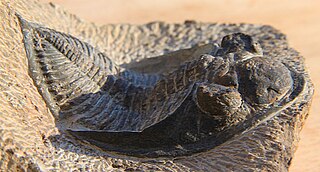
Odontochile is a genus of trilobites in the order Phacopida, family Dalmanitidae.

Crotalocrinites, also known as the feather star, is a genus of extinct sea lily belonging to the family Crotalocrinitidae. These feather stars were stationary intermediate-level organisms feeding on suspension epifauna. They lived in the Silurian period, from the Upper Wenlock age to the Ludlow age.

Inversoceras is a genus of cephalopods in the order Oncocerida and the family Trimeroceratidae. These mollusks were fast-moving nektobenthic carnivores. They lived in the Silurian period, from the Lower Wenlock age to the Ludlow age.

Strophomena is a genus of brachiopods belonging to the order Strophomenida family Strophomenidae, named by Rafinesque in 1824. They were stationary epifaunal suspension feeders.
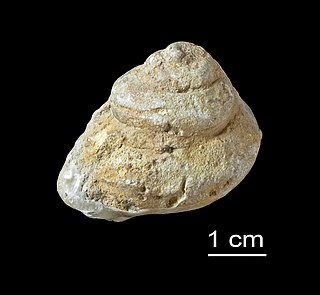
Holopea is an extinct genus of fossil sea snails, Paleozoic gastropod mollusks in the family Holopeidae.

Panenka is a genus of fossil saltwater clams, marine bivalve molluscs in the family Praecardiidae. Like most bivalves, these molluscs were suspension feeders. They lived in the Devonian Period.

Panderia is a genus of trilobites in the order Corynexochida.

Coronocephalus is an extinct genus of trilobites in the Phacopid family Encrinuridae. Species are from the Silurian of Australia and Japan, and from the Silurian and Ordovician of China.



















